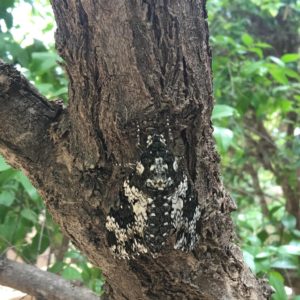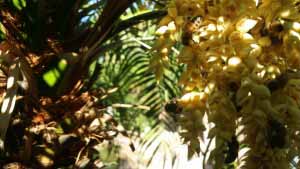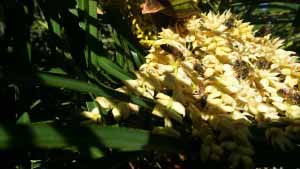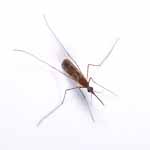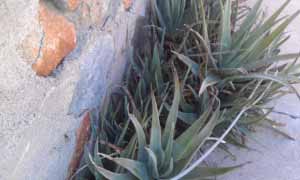Funky Caterpillar artwork
Funky Caterpillar and metal artwork is the new normal for outside decorations, I love some of the new stuff including this Caterpillar. Nice planter and decorative at the same time. Adds a little color to the home and you don’t have to have any real bugs. You know you can always call ProBest Pest Management 480-831-9328 if you see any critters within your home?
I don’t mind these decorations but no sense in living with the bugs. I have seen decorative rock, wire ants and even birds and flowers. What kind of artwork is at your home?
Where do pests hang out?
Are there pests hanging out on a tree nearby your home, this moth is home is warm climates. Caterpillars are known as horn worms and the adults may resemble hummingbirds due to their size. Can be found throughout the south as far as Argentina. The adults frequent deep-throated flowers, similar to that which hummingbirds visit. This moth really isn’t a pest but if you have trees touching your home you might be inviting them into your home. What is that tree housed an any colony, they would travel up a limb and right into your home and you might not know where they are coming from. What about Roof rats, another bridge right into your home. Ohhh and don’t get me started on vines on your home, you know what I would say, right? What about those flies, yuuuuck!
There are good bugs.
Often times we just see a bug and we are prepared to exterminate it. This shouldn’t be our first thought, there are many bugs that aren’t pests. Butterflies and moths pollinate several different species of plants and flowers. Ladybugs eat a ton of aphids and spiders keep down those occasional invaders like crickets and earwigs. Hoping that in the future we can just pick a DNA strand and pick off whatever bug is eating our food or coming at our homes and businesses. This would allow the beneficial bugs that chance to continue to do what they do, protect and eat all those nasty bugs. The technology might be just around the corner, no harm to beneficials and only those that are a menace. Can you imagine a farmer having a plan to just take out the harmful bugs and leaving behind the good bugs. I’m sure the Praying Mantids, ladybugs and spiders will thank us later.
I often have to walk around bushes and trees and sometimes they are just a humming with activity. This is the case in the Spring, people often get freaked out with all the activity. Honeybees are very important to our lives, 1/3 of all the food we eat are pollinated by bees. The only real time to be worried about honeybees is when they have taken up a home within your home. In this case they have something to defend, and defend it they will especially Africanized honeybees. Africanized honeybees are more prone to attack just because of a smell or lawnmower noise. They are virtually the same size as European honeybees and swarm 2 to 3 times more often Just use caution, unless you are allergic and then use extreme caution especially if there is a hive close to your home. If you are hiking some colonies will bump you to tell you they are close, just back away. Generally speaking swarms won’t attack unless you mess with them, they are full of honey and not yet defending a hive or colony. So don’t mess with them and they probably won’t mess with you.
Bee careful out there.
Bats are great and need your love. Here are a few facts & tips:
- Babies are born furless.
- Only mammal to fly.
- Bats eat lots of bugs, disperse seeds and pollinate plants.
- They can eat their body weight in bugs each night, that would be like us eating 80 pizzas.
What can you do to prevent them from making your home theirs and to encourage them at your home.
- Exclusion work must be done out of season and at night.
- Install a bat house around your home Bat Conservation International.
Never pick up a bat, they do bite!
Bugs can and will move if given the opportunities. I have spoken about this before and I train my technicians to know about the bugs in others areas just so we can be sure if one pops up. What do I mean by this statement?
Example #1 – Someone moves from Kansas and they store their boxes in a temporary storage facility. They then move across the country and they accidentally bring a spider or other pest across state lines.
Example #2 – Someone visiting from another country visits the US and brings in a piece of fruit which as bugs on it.
Example #3 – Someone moves to Arizona and brings a potted plant with them.
All these stories could be true and the USDA does a great job of tracking and stopping some of these pests from moving around. A recent Aphid – SugarCane Aphid has been in Florida since 1977 and recently was discovered in Texas. Bugs do move and given the right circumstances will take advantage of every possible chance to move to another location.
I have noticed lately especially after the rains that we have had numerous calls about flying biting mosquitoes. With all the monsoon rains, a lot of the things that hold water have had the chance to really set things in motion for the issues with biting pests.
Water can accumulate in any container that can hold water, fountains that aren’t working and any indention in the ground. So again I will mention surveying your property monthly or at the very least when the rains occur.
Remember the 3 things that most living things need:
- Food
- Shelter
- Water
Some mosquitoes are well suited for inhabiting local areas but some can travel up to mile just to feed. So tip over those devices that can hold water, don’t forget saucers for planters.
If you have wood siding please consider the following:
- Remember when it rains, the wood will act like a sponge and wick the water up.
- Don’t plant grass or any type of plant to close, the plan is to make the foundation visible for inspections.
- Just my opinion but don’t plant anything under the drip-line of the home. That is where the roof extends out away from the house.
Skunks
- Skunks generally forage at night and are considered omnivores (they will eat anything) eat plants, berries, grass, bugs, worms, eggs, reptiles & rodents.
- Skunks don’t have the best eyesight but have excellent hearing.
- Ther prefer to live in burrows.
- Skunks actually sneeze to clear out their noses so they can better smell plant food or animal prey.
- If you get sprayed, only time will help to fade the smell, tomato juice and/or vingear will help to mask the smell – by the way scientists believe its the oil that makes it last.
- Stay back if you spot a skunk, it can shoot up to 10 feet and less accurate to 16 feet.
When you plant bushes, trees or plants next to your home, are you creating an environment for pests and termites? Probably so. My rule of thumb is not to plant anything within 2 feet of your structure. Normally this is what I call the dripline of your home, that is the area of the roof over hang. Sometimes we really don’t have a chance, the picture below is an example of this. Because of the sidewalk there isn’t any room and when and if a termite job is required on this home, all those plants will probably be destoyed or hopefully they can be moved. The other issue is when the plants attract pests, could they then move into your structure? So think before you plant and things should be OK on the bug side…




